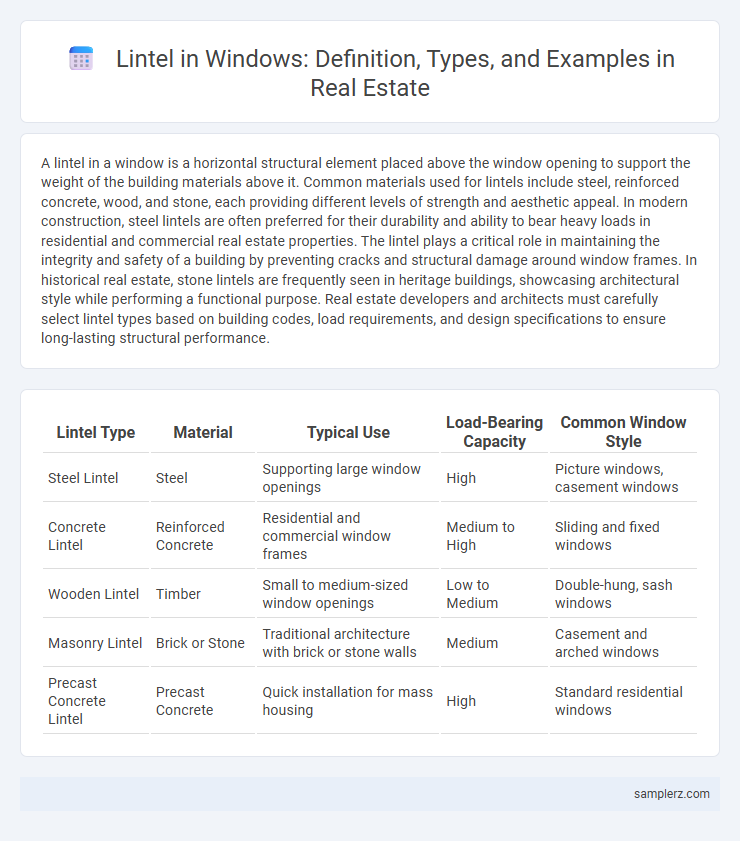A lintel in a window is a horizontal structural element placed above the window opening to support the weight of the building materials above it. Common materials used for lintels include steel, reinforced concrete, wood, and stone, each providing different levels of strength and aesthetic appeal. In modern construction, steel lintels are often preferred for their durability and ability to bear heavy loads in residential and commercial real estate properties. The lintel plays a critical role in maintaining the integrity and safety of a building by preventing cracks and structural damage around window frames. In historical real estate, stone lintels are frequently seen in heritage buildings, showcasing architectural style while performing a functional purpose. Real estate developers and architects must carefully select lintel types based on building codes, load requirements, and design specifications to ensure long-lasting structural performance.
Table of Comparison
| Lintel Type | Material | Typical Use | Load-Bearing Capacity | Common Window Style |
|---|---|---|---|---|
| Steel Lintel | Steel | Supporting large window openings | High | Picture windows, casement windows |
| Concrete Lintel | Reinforced Concrete | Residential and commercial window frames | Medium to High | Sliding and fixed windows |
| Wooden Lintel | Timber | Small to medium-sized window openings | Low to Medium | Double-hung, sash windows |
| Masonry Lintel | Brick or Stone | Traditional architecture with brick or stone walls | Medium | Casement and arched windows |
| Precast Concrete Lintel | Precast Concrete | Quick installation for mass housing | High | Standard residential windows |
Understanding Lintels: Definition and Importance in Window Construction
Lintels are horizontal structural elements placed above window openings to support the load from the building materials above, such as bricks or concrete blocks. Common materials for lintels include reinforced concrete, steel, and timber, chosen based on the structural requirements and aesthetic considerations. Proper installation of lintels ensures window stability, prevents cracks around frames, and enhances the overall integrity of the building facade.
Common Materials Used for Window Lintels
Window lintels in real estate construction are typically made from reinforced concrete, steel, or timber, each offering distinct structural benefits. Reinforced concrete lintels provide excellent load-bearing capacity and durability, commonly used in modern buildings. Steel lintels offer high strength with a slim profile, ideal for larger openings, while timber lintels are favored for aesthetic appeal in traditional or residential properties.
Typical Design and Placement of Lintels Above Windows
Lintels above windows are typically designed using reinforced concrete, steel, or timber to support the load from the structure above while allowing for open window spaces. The placement of lintels is directly above the window frame, ensuring even distribution of weight along the wall to prevent cracks and structural damage. Standard dimensions and positioning comply with building codes, generally extending beyond the window opening by at least 150mm on each side to enhance load transfer and stability.
Example of Reinforced Concrete Lintel in Modern Homes
A reinforced concrete lintel in modern homes typically spans window openings, providing strong structural support while allowing for wide, unobstructed views. These lintels are designed with steel reinforcement bars embedded within the concrete to resist bending and shear forces, ensuring durability and safety. This type of lintel enhances the aesthetic appeal by enabling larger window installations without compromising the building's integrity.
Brick Lintel Installation in Traditional Window Frames
Brick lintel installation in traditional window frames enhances structural integrity by evenly distributing the weight above the opening. This method typically involves laying bricks horizontally with mortar, creating a sturdy support that blends seamlessly with brick facades. Proper alignment and curing of the brick lintel prevent cracks and ensure long-lasting durability in classic masonry constructions.
Timber Lintels: Classic Solutions for Residential Windows
Timber lintels are a classic solution for residential windows, offering a natural aesthetic that complements traditional and rustic home designs. Made from durable hardwood, these lintels provide reliable structural support while enhancing the architectural character of the window openings. Their versatility allows easy customization in size and finish, making them ideal for both restoration projects and new builds in residential real estate.
Steel Lintels for Large Window Openings: A Practical Example
Steel lintels are essential for large window openings in modern construction, providing superior strength and support compared to traditional materials. For example, a commercial building might use a steel lintel measuring 10 feet in length and designed to support a 500-pound load to ensure stability and prevent structural sagging. Their versatility in accommodating various architectural designs makes steel lintels a preferred choice in real estate developments featuring expansive glass panes.
Precast Lintel Types Used in Urban Apartment Windows
Precast lintels in urban apartment windows commonly include reinforced concrete lintels, offering high durability and load-bearing capacity for multi-story buildings. Hollow core precast lintels reduce weight without compromising strength, facilitating faster installation and enhanced thermal insulation. T-beam lintels integrate seamlessly with facade designs, providing both structural support and aesthetic appeal in modern urban residential constructions.
Comparison: Stone vs. Concrete Lintels for Window Applications
Stone lintels offer superior aesthetic appeal and natural durability, making them ideal for traditional or historic window designs, while concrete lintels provide enhanced structural strength and cost-efficiency for modern construction projects. Concrete lintels can be pre-cast with precise dimensions and reinforced for added load-bearing capacity, outperforming stone in terms of uniformity and ease of installation. Maintenance-wise, stone lintels may require sealing to prevent weathering, whereas concrete lintels benefit from consistent performance with minimal upkeep in various environmental conditions.
Key Considerations in Choosing the Right Lintel for Your Window
Selecting the right lintel for your window requires careful assessment of load-bearing capacity, material durability, and compatibility with the building structure. Steel lintels offer high tensile strength suitable for wider openings, while reinforced concrete lintels provide excellent compressive resistance for multi-story buildings. Ensuring proper lintel size and installation according to architectural specifications prevents structural issues and enhances window longevity.

example of lintel in window Infographic
 samplerz.com
samplerz.com